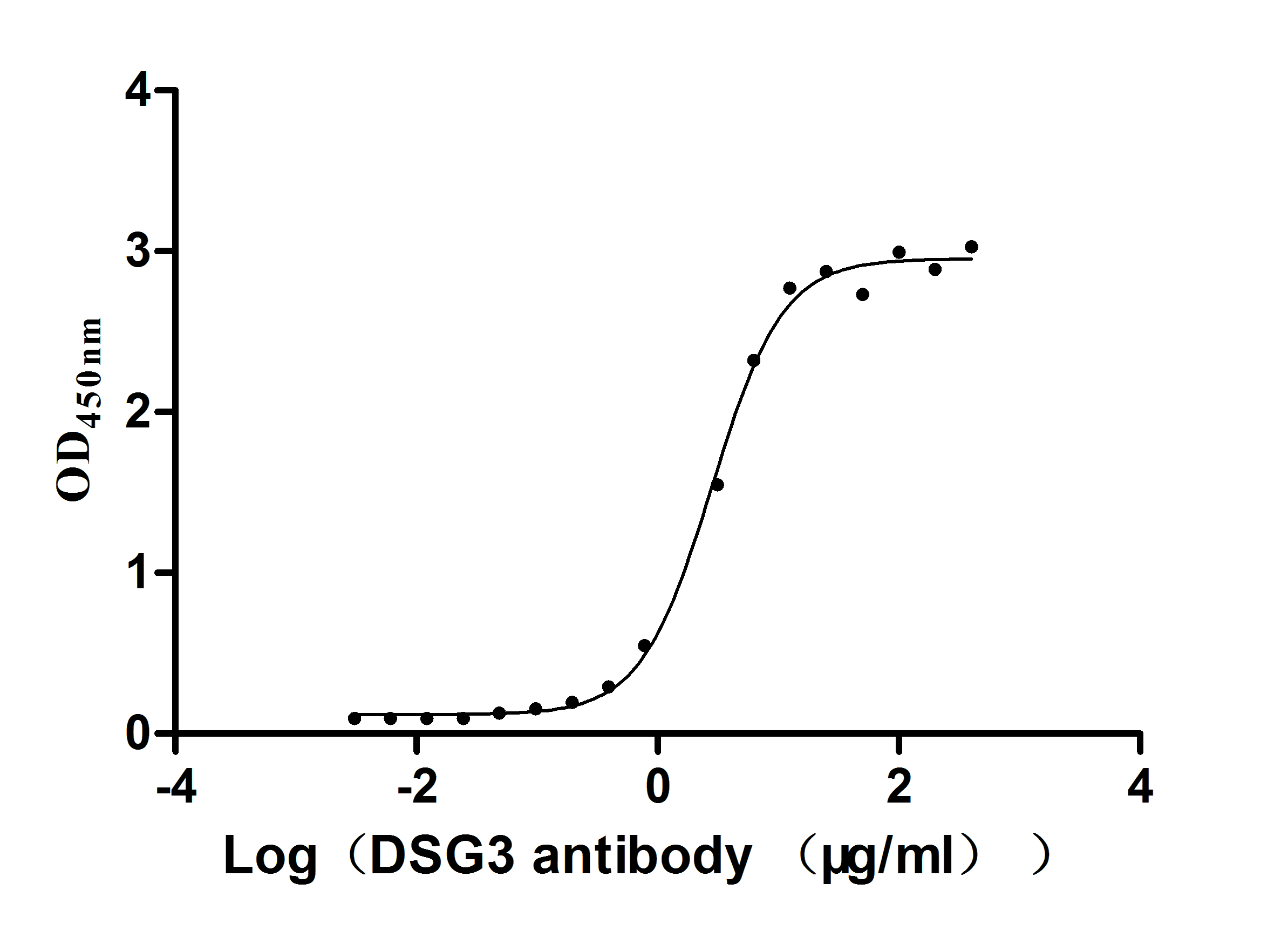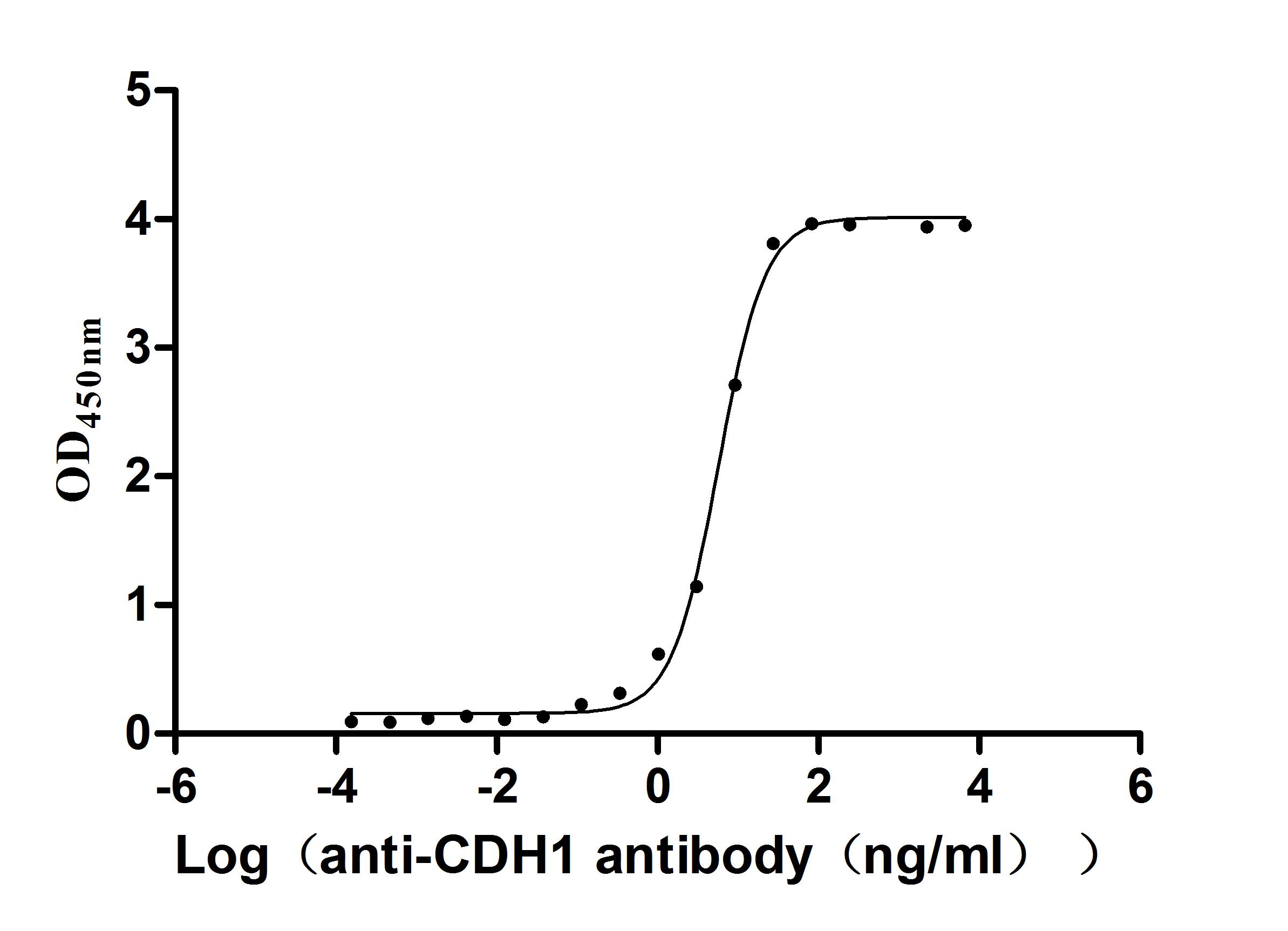Recombinant Mouse Sclerostin (Sost)
-
货号:CSB-YP858168MO
-
规格:
-
来源:Yeast
-
其他:
-
货号:CSB-EP858168MO
-
规格:
-
来源:E.coli
-
其他:
-
货号:CSB-EP858168MO-B
-
规格:
-
来源:E.coli
-
共轭:Avi-tag Biotinylated
E. coli biotin ligase (BirA) is highly specific in covalently attaching biotin to the 15 amino acid AviTag peptide. This recombinant protein was biotinylated in vivo by AviTag-BirA technology, which method is BriA catalyzes amide linkage between the biotin and the specific lysine of the AviTag.
-
其他:
产品详情
-
纯度:>85% (SDS-PAGE)
-
基因名:
-
Uniprot No.:
-
别名:Sost; Sclerostin
-
种属:Mus musculus (Mouse)
-
蛋白长度:Full Length of Mature Protein
-
表达区域:24-211
-
氨基酸序列QGWQAFR NDATEVIPGL GEYPEPPPEN NQTMNRAENG GRPPHHPYDA KGVSEYSCRE LHYTRFLTDG PCRSAKPVTE LVCSGQCGPA RLLPNAIGRV KWWRPNGPDF RCIPDRYRAQ RVQLLCPGGA APRSRKVRLV ASCKCKRLTR FHNQSELKDF GPETARPQKG RKPRPGARGA KANQAELENA Y
-
蛋白标签:Tag type will be determined during the manufacturing process.
The tag type will be determined during production process. If you have specified tag type, please tell us and we will develop the specified tag preferentially. -
产品提供形式:Lyophilized powder
Note: We will preferentially ship the format that we have in stock, however, if you have any special requirement for the format, please remark your requirement when placing the order, we will prepare according to your demand. -
复溶:We recommend that this vial be briefly centrifuged prior to opening to bring the contents to the bottom. Please reconstitute protein in deionized sterile water to a concentration of 0.1-1.0 mg/mL.We recommend to add 5-50% of glycerol (final concentration) and aliquot for long-term storage at -20℃/-80℃. Our default final concentration of glycerol is 50%. Customers could use it as reference.
-
储存条件:Store at -20°C/-80°C upon receipt, aliquoting is necessary for mutiple use. Avoid repeated freeze-thaw cycles.
-
保质期:The shelf life is related to many factors, storage state, buffer ingredients, storage temperature and the stability of the protein itself.
Generally, the shelf life of liquid form is 6 months at -20°C/-80°C. The shelf life of lyophilized form is 12 months at -20°C/-80°C. -
货期:Delivery time may differ from different purchasing way or location, please kindly consult your local distributors for specific delivery time.Note: All of our proteins are default shipped with normal blue ice packs, if you request to ship with dry ice, please communicate with us in advance and extra fees will be charged.
-
注意事项:Repeated freezing and thawing is not recommended. Store working aliquots at 4°C for up to one week.
-
Datasheet :Please contact us to get it.
相关产品
靶点详情
-
功能:Negative regulator of bone growth that acts through inhibition of Wnt signaling and bone formation.
-
基因功能参考文献:
- The SOST gene inhibited the expression of COL1, OCN, and OPN, reduced the activity of alkaline phosphatase, and increased the expression of LPL and PPARgamma. PMID: 30041240
- Since adipocytes do not produce sclerostin, these findings suggest an unexplored endocrine function for sclerostin that facilitates communication between the skeleton and adipose tissue. PMID: 29229807
- A microtubule-dependent mechanotransduction pathway that linked fluid shear stress to reactive oxygen species and calcium (Ca2+) signals that led to a reduction in sclerostin abundance in cultured osteocytes. PMID: 29162742
- osteoclast-derived LIF regulates bone turnover through sclerostin expression. PMID: 28543818
- our study provided histological evidences that sclerostin tends to be secreted in osteocytes of remodeled mature bone, while FGF23 would be differently synthesized in osteoblasts and osteocytes according to the developmental stages PMID: 28794403
- These results show that osteocytes and/or osteoblasts secrete factors regulating beige adipogenesis, at least in part, through the Wnt-signaling inhibitor sclerostin. PMID: 27653320
- In vivo muCT analysis of cortical bone at age 1 and 3 months confirmed increased thickness in Sost-/-mice, but revealed no cortical abnormalities in single Gja1+/-or Sost+/-mice PMID: 29149200
- loss of BMP signaling specifically in osteocytes dramatically increases bone mass presumably through simultaneous inhibition of RANKL and SOST, leading to osteoclast inhibition and Wnt activation together. PMID: 27402532
- humanized Multiple Myeloma xenograft mouse model bearing human MM cells (NOD-SCID.CB17 male mice injected intravenously with 2.5 million of MM1.S-Luc-GFP cells) demonstrated significantly higher concentrations of mouse-derived sclerostin, suggesting a microenvironmental source of sclerostin. PMID: 26763740
- Protection From Glucocorticoid-Induced Osteoporosis by Anti-Catabolic Signaling in the Absence of Sost/Sclerostin PMID: 27163932
- Osteocyte-derived molecule sclerostin drives bone marrow adipogenesis. PMID: 28460416
- complete absence of sclerostin has only minor effects on chronic kidney disease-induced bone loss in mice. PMID: 27528549
- In mice, sclerostin deficiency hastened reparative dentinogenesis after pulp injury, suggesting that the inhibition of sclerostin may constitute a promising therapeutic strategy for improving the healing of damaged pulps. PMID: 28571484
- These data suggest that sclerostin plays an important role in the bone remodeling of tooth movement. PMID: 28081119
- Sclerostin inhibits angiotensin II-induced aortic aneurysm and atherosclerosis via wnt signaling pathway inhibition. PMID: 28062506
- Analysis of SOST expression using large minigenes reveals the MEF2C binding site in the evolutionarily conserved region (ECR5) enhancer mediates forskolin, but not 1,25-dihydroxyvitamin D3 or TGFbeta1 responsiveness. PMID: 26361013
- removal of sclerostin appears to modestly protect the alveolar bone from resorption in this experimental setting PMID: 27349550
- chronic TNFalpha (tumor necrosis factor alpha)-dependent arthritis, fibroblast-like synoviocytes constitute a major source of sclerostin and that either the lack of sclerostin or its antibody-mediated inhibition leads to an acceleration of rheumatoid arthritis (RA)-like disease. PMID: 27089204
- Data show that the phenotype of Notch activation in osteocytes was prevented in matrix protein 1 (Dmp1)-Cre;Rosa(Notch) mice hemizygous for the Dmp1-sclerostin (SOST) transgene. PMID: 26456319
- Results found that sclerostin enhances adipocyte differentiation in 3T3-L1 cells and reduced TAZ-responsive transcriptional activity and TAZ-responsive gene expression, indicating a role for TAZ as a regulator of adipogenesis by sclerostin. PMID: 26553151
- Our results suggested that sclerostin could be expressed in the liver and sustained successfully at high levels in the blood by using the PhiC31 integrase system, leading to trabecular bone loss. PMID: 26845353
- Sclerostin depletion enhances tibial fracture healing. PMID: 26608966
- SOST gene is involved in the regulation of renal interstitial fibrosis (RIF) progression. In obstructive kidney injury, SOST gene deletion would probably enhance renal fibrogenic response and promote the progression of RIF. PMID: 26337453
- Data (including data from studies in knockout/transgenic mice) suggest that Lrp6 (lipoprotein receptor-related protein 6) is required for suppression of Sost expression by parathyroid hormone (here, human PTH peptide 1-34). PMID: 25847683
- These in vivo data support in vitro studies regarding the mechanism of HBM-causing mutations, and imply that HBM LRP5 receptors differ in their relative sensitivity to inhibition by SOST and DKK1. PMID: 25808845
- These findings indicated that AMPK regulated RANKL and sclerostin expression through the mevalonate pathway in osteocytes. PMID: 26713363
- Sclerostin inhibits bone formation through Lrp5 interaction. PMID: 25640331
- thyroid hormone-induced changes in bone remodeling are associated with a divergent regulation of DKK1 and sclerostin PMID: 26218891
- increased sclerostin production achieved by HDAC5 shRNA is abrogated by simultaneous knockdown of MEF2C, indicating that MEF2C is a major target of HDAC5 in osteocytes PMID: 25271055
- sclerostin is regulated by glutathione, N-acetylcysteine and lipoic acid in osteocytes in a process involving JNK and ERK1/2 PMID: 25660312
- Estrogen replacement treatment in ovariectomized ER beta KO mice caused a significant increase in Col2 expression, no change in ER alpha expression, and a significant increase in Sost expression. PMID: 25046534
- Simulated microgravity induces an autonomous up-regulation of sclerostin. PMID: 25953900
- deleting the Sost gene (a potent inhibitor of WNT signaling) or blocking sclerostin function by using the mAb in a periodontitis model significantly restores bone and periodontal ligament defects PMID: 25757567
- bony union was not altered by Sclerostin deficiency in externally-fixed closed tibial fractures, but fibrocartilage removal was enhanced and the resultant united bony calluses had increased bone fraction and increased strength. PMID: 25445453
- Advanced glycation end products increased sclerostin as well as apoptosis, and decreased RANKL in osteocytes. PMID: 25721666
- long-term Sclerostin deficiency inhibits the bone loss normally induced with decreased mechanical load, but it can augment the increase in bone formation with increased load. PMID: 24821585
- Findings strongly suggest that Wise and Sost are key modulators of bone development through the ability of their encoded proteins to interact with Lrp5 and control the balance or levels of Wnt signaling. PMID: 24789067
- the altered bone composition contributes to the increased bone strength of patients with sclerostin deficiency. PMID: 24753092
- Data indicate that both Dickkopf-1 (DKK1) and sclerostin (SOST) were downregulated in proteoglycan-induced spondylitis (PGISp)-affected mouse spines. PMID: 23171658
- Data indicate that LRP4 (low-density lipoprotein receptor-related protein 4) deficiency in bone dramatically elevated serum sclerostin levels whereas bone expression of Sost encoding for sclerostin was unaltered. PMID: 25404300
- importance of the flexible loop and the cystine-knot for Wnt-signaling inhibition PMID: 24312339
- Evidence is accumulating that sclerostin directly or indirectly reduces renal calcium reabsorption [review]. PMID: 24876121
- Data indicate that low-dose parathyroid hormone (PTH) decreased the expression of the myocyte enhancer factor 2C (Mef2c) transcription factor, resulting in decreased sclerostin (Sost) expression in osteoblasts/osteocytes. PMID: 25056116
- Ovariectomy resulted in a substantial decrease in skeletal Sirt1 expression accompanied by an increase in sclerostin. PMID: 24949665
- results suggest that the lack of sclerostin mainly alters the bone and cementum phenotypes rather than producing abnormalities in tooth structures such as dentin PMID: 24699186
- Data indicate that sclerostin blockade restored bone mineral density (BMD) and bone volume fraction at all assessed sites but was unable to repair focal erosions. PMID: 24432364
- In the absence of LRP5, the anabolic effects of SOST depletion can occur via other receptors (such as LRP4/6) PMID: 24225945
- sclerostin upregulated osteocyte expression of carbonic anhydrase 2. PMID: 23737439
- these data indicate that enhanced beta-catenin signaling is present in Sost(-/-) mice that demonstrate accelerated healing of bone defects, suggesting that modulation of beta-catenin signaling in bone could be used to promote fracture repair. PMID: 24211207
- These results support a model in which, in the context of obesity or other inflammatory diseases that increase the production of TNF-alpha, TNF-alpha upregulates the expression of sclerostin through NF-kappaB signaling pathway, thus contributing to bone loss. PMID: 24446199
显示更多
收起更多
-
亚细胞定位:Secreted, extracellular space, extracellular matrix.
-
蛋白家族:Sclerostin family
-
数据库链接:
KEGG: mmu:74499
STRING: 10090.ENSMUSP00000001534
UniGene: Mm.265602
Most popular with customers
-
Recombinant Mouse Desmoglein-3 (Dsg3), partial (Active)
Express system: Mammalian cell
Species: Mus musculus (Mouse)
-
Recombinant Human C5a anaphylatoxin chemotactic receptor 1 (C5AR1)-VLPs (Active)
Express system: Mammalian cell
Species: Homo sapiens (Human)
-
Recombinant Human Trophoblast glycoprotein (TPBG), partial (Active)
Express system: Mammalian cell
Species: Homo sapiens (Human)
-
Recombinant Human Glucagon-like peptide 1 receptor (GLP1R), partial (Active)
Express system: Mammalian cell
Species: Homo sapiens (Human)
-
Recombinant Human C-C chemokine receptor type 8 (CCR8)-VLPs (Active)
Express system: Mammalian cell
Species: Homo sapiens (Human)
-
Recombinant Human Serotransferrin(TF) (Active)
Express system: Mammalian cell
Species: Homo sapiens (Human)
-
Recombinant Human Cadherin-1(CDH1),partial (Active)
Express system: Mammalian cell
Species: Homo sapiens (Human)
-
Recombinant Human Kidney-associated antigen 1(KAAG1) (Active)
Express system: Baculovirus
Species: Homo sapiens (Human)




















